Kuppan T. Heat Exchanger Design Handbook
Подождите немного. Документ загружается.

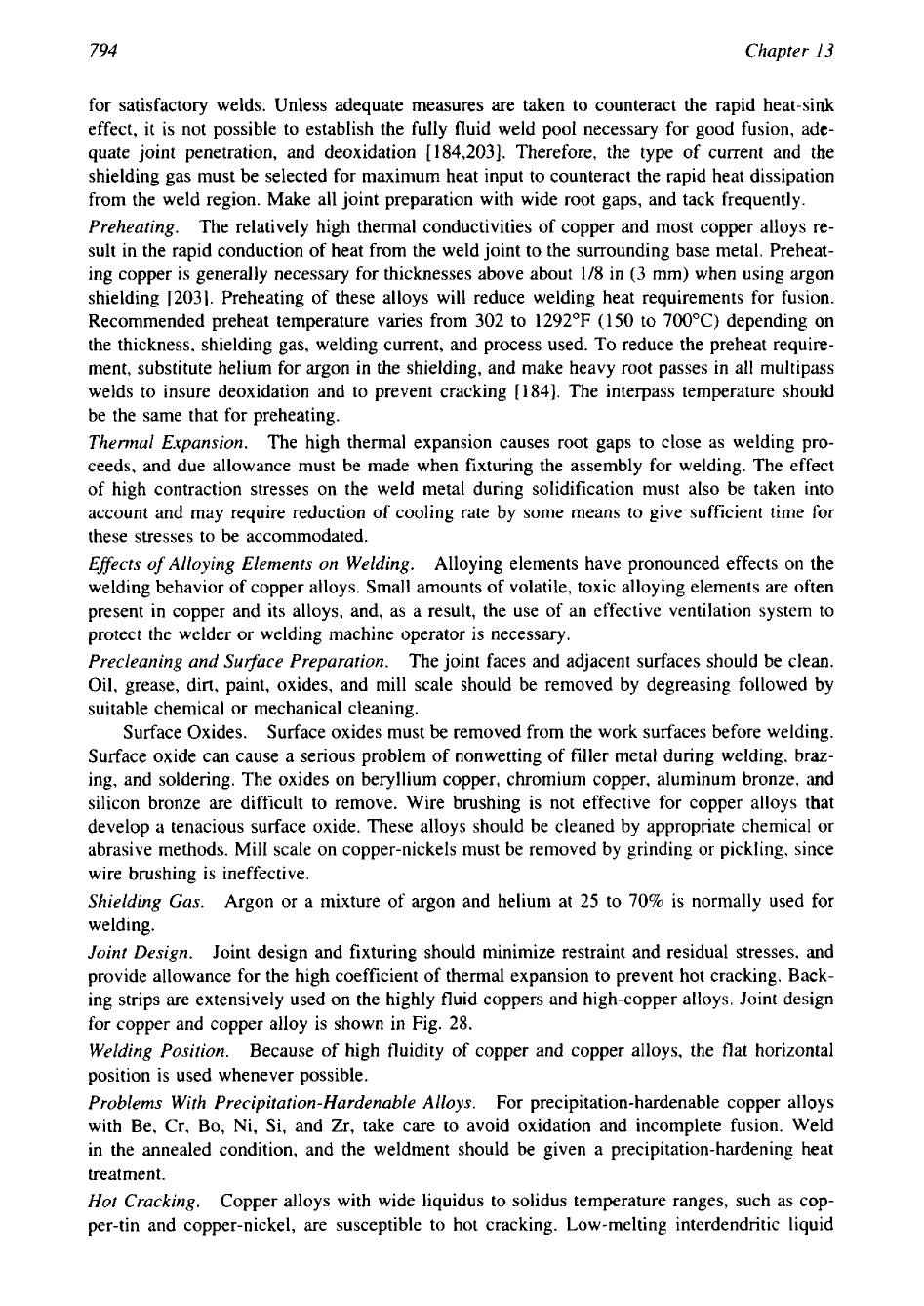
794
Chapter
I3
for satisfactory welds. Unless adequate measures are taken to counteract the rapid heat-sink
effect, it is not possible to establish the fully fluid weld pool necessary for good fusion, ade-
quate joint penetration, and deoxidation [184,203]. Therefore, the type of current and the
shielding gas must be selected for maximum heat input to counteract the rapid heat dissipation
from the weld region. Make all joint preparation with wide root gaps, and tack frequently.
Preheating.
The relatively high thermal conductivities of copper and most copper alloys re-
sult in the rapid conduction of heat from the weld joint to the surrounding base metal. Preheat-
ing copper is generally necessary for thicknesses above about 1/8 in
(3
mm) when using argon
shielding [203
1.
Preheating of these alloys will reduce welding heat requirements for fusion.
Recommended preheat temperature varies from 302 to 1292°F (150 to
700°C)
depending on
the thickness, shielding gas, welding current, and process used. To reduce the preheat require-
ment, substitute helium for argon in the shielding, and make heavy root passes in all multipass
welds to insure deoxidation and to prevent cracking
[
1841. The interpass temperature should
be the same that for preheating.
Thermal Expansion.
The high thermal expansion causes root gaps to close as welding pro-
ceeds, and due allowance must be made when fixturing the assembly for welding. The effect
of high contraction stresses on the weld metal during solidification must also be taken into
account and may require reduction of cooling rate by some means to give sufficient time for
these stresses to be accommodated.
Eflects
of
Alloying Elements
on
Welding.
Alloying elements have pronounced effects on the
welding behavior of copper alloys. Small amounts of volatile, toxic alloying elements are often
present in copper and its alloys, and, as a result, the use of an effective ventilation system to
protect the welder or welding machine operator is necessary.
Precleaning and Su@ace Preparation.
The joint faces and adjacent surfaces should be clean.
Oil, grease, dirt, paint, oxides, and mill scale should be removed by degreasing followed by
suitable chemical or mechanical cleaning.
Surface Oxides.
Surface oxides must be removed from the work surfaces before welding.
Surface oxide can cause a serious problem of nonwetting
of
filler metal during welding, braz-
ing, and soldering. The oxides on beryllium copper, chromium copper, aluminum bronze,
and
silicon bronze are difficult to remove. Wire brushing is not effective for copper alloys that
develop
a
tenacious surface oxide. These alloys should be cleaned by appropriate chemical or
abrasive methods. Mill scale on copper-nickels must be removed by grinding or pickling, since
wire brushing is ineffective.
Shielding
Gas.
Argon or a mixture of argon and helium at 25 to
70%
is normally used for
welding.
Joint Design.
Joint design and fixturing should minimize restraint and residual stresses, and
provide allowance for the high coefficient of thermal expansion to prevent hot cracking. Back-
ing strips are extensively used on the highly fluid coppers and high-copper alloys. Joint design
for copper and copper alloy is shown in Fig.
28.
Welding Position.
Because of high fluidity of copper and copper alloys, the flat horizontal
position is used whenever possible.
Problems
With
Precipitation-Hardenable
Alloys.
For
precipitation-hardenable
copper alloys
with Be, Cr, Bo, Ni, Si, and Zr, take care to avoid oxidation and incomplete fusion. Weld
in the annealed condition, and the weldment should be given a precipitation-hardening heat
treatment.
Hot Cracking.
Copper alloys with wide liquidus to solidus temperature ranges, such as cop-
per-tin and copper-nickel, are susceptible to hot cracking. Low-melting interdendritic liquid
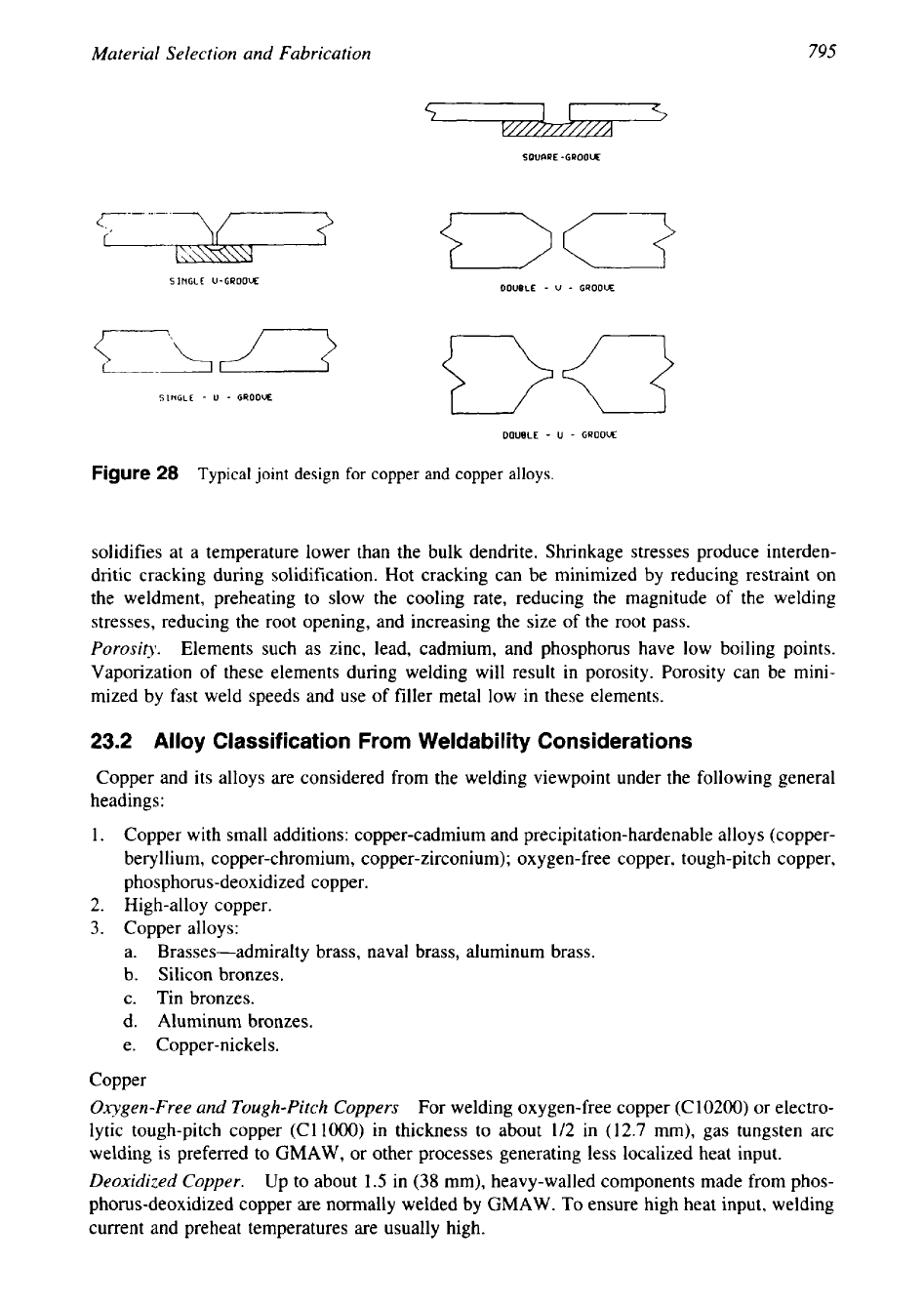
795
Material Selection and Fabrication
<
SOUPRE
-GROOS
SINGLE
U-GROOUE
DOUBLE
-
U
-
CROOK
SINGLE
-
U
-
GRDDUE
DOUBLE
-
U
-
GROOM
Figure
28
Typical joint design
for
copper and copper alloys.
solidifies at a temperature lower than the bulk dendrite. Shrinkage stresses produce interden-
dritic cracking during solidification.
Hot
cracking can be minimized by reducing restraint on
the weldment, preheating to slow the cooling rate, reducing the magnitude of the welding
stresses, reducing the root opening, and increasing the size of the root pass.
Porosity.
Elements such as zinc, lead, cadmium, and phosphorus have low boiling points.
Vaporization of these elements during welding will result in porosity. Porosity can be mini-
mized by fast weld speeds and use of filler metal low in these elements.
23.2
Alloy
Classification From Weldability Considerations
Copper and its alloys are considered from the welding viewpoint under the following general
headings:
1. Copper with small additions: copper-cadmium and precipitation-hardenable alloys (copper-
beryllium, copper-chromium, copper-zirconium); oxygen-free copper, tough-pitch copper,
phosphorus-deoxidized copper.
2. High-alloy copper.
3.
Copper alloys:
a.
Brasses-admiralty brass, naval brass, aluminum brass.
b. Silicon bronzes.
c. Tin bronzes.
d. Aluminum bronzes.
e.
Copper-nickels.
Copper
Oxygen-Free and Tough-Pitch Coppers
For welding oxygen-free copper (C 10200) or electro-
lytic tough-pitch copper (C11000) in thickness to about 1/2 in (12.7 mm), gas tungsten arc
welding is preferred to
GMAW,
or
other processes generating less localized heat input.
Deoxidized Copper.
Up to about 1.5 in
(38
mm), heavy-walled components made from phos-
phorus-deoxidized copper are normally welded by
GMAW.
To ensure high heat input, welding
current and preheat temperatures are usually high.
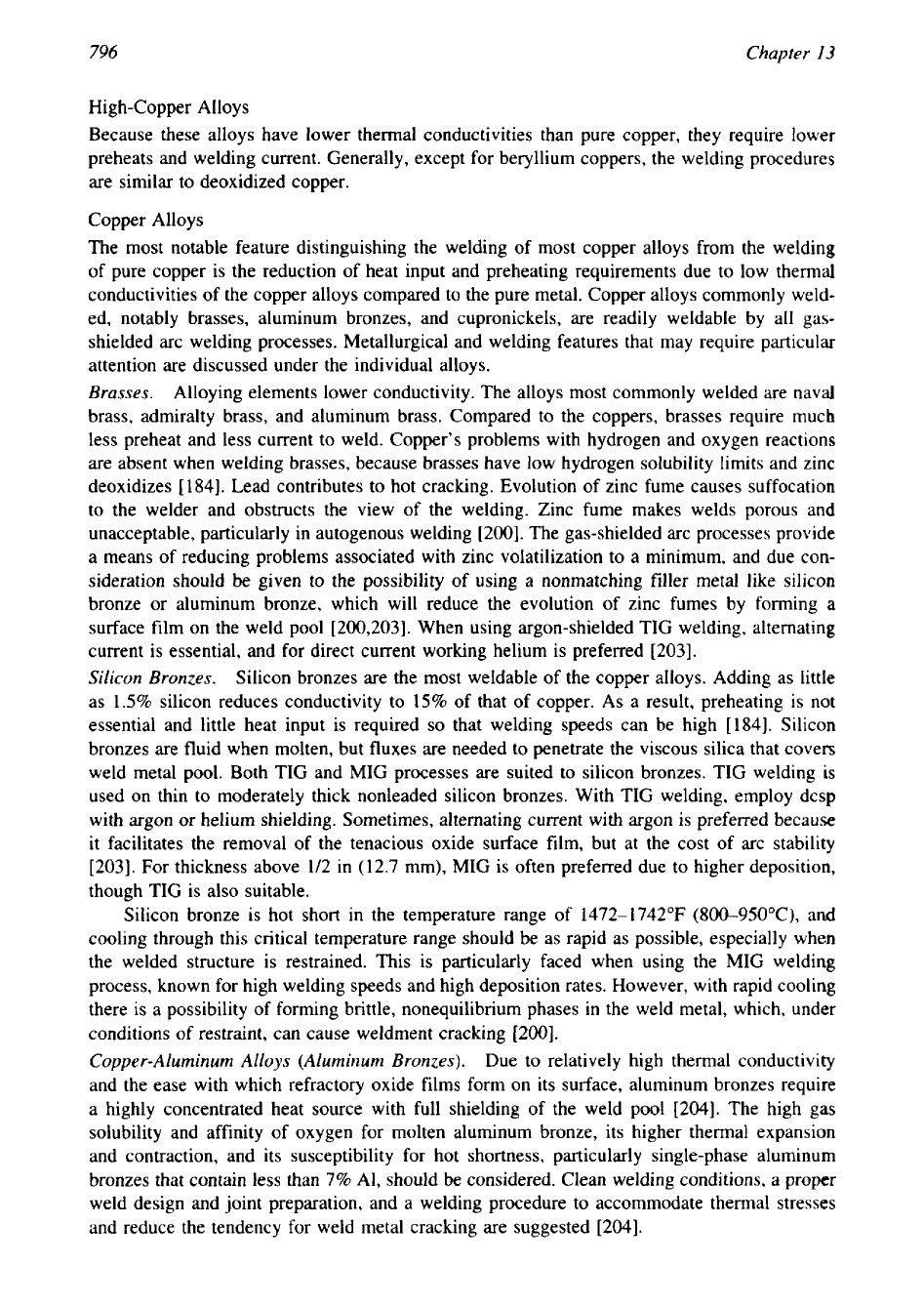
796
Chapter
I3
High-Copper Alloys
Because these alloys have lower thermal conductivities than pure copper, they require lower
preheats and welding current. Generally, except for beryllium coppers, the welding procedures
are similar to deoxidized copper.
Copper Alloys
The most notable feature distinguishing the welding of most copper alloys from the welding
of pure copper is the reduction of heat input and preheating requirements due to low thermal
conductivities of the copper alloys compared to the pure metal. Copper alloys commonly weld-
ed, notably brasses, aluminum bronzes, and cupronickels, are readily weldable by all gas-
shielded arc welding processes. Metallurgical and welding features that may require particular
attention are discussed under the individual alloys.
Brasses.
Alloying elements lower conductivity. The alloys most commonly welded are naval
brass, admiralty brass, and aluminum brass. Compared to the coppers, brasses require much
less preheat and less current to weld. Copper’s problems with hydrogen and oxygen reactions
are absent when welding brasses, because brasses have low hydrogen solubility limits and zinc
deoxidizes
[
1841. Lead contributes to hot cracking. Evolution of zinc fume causes suffocation
to the welder and obstructs the view of the welding. Zinc fume makes welds porous and
unacceptable, particularly in autogenous welding [200]. The gas-shielded arc processes provide
a means of reducing problems associated with zinc volatilization to a minimum, and due con-
sideration should be given to the possibility of using a nonmatching filler metal like silicon
bronze or aluminum bronze, which will reduce the evolution of zinc fumes by forming
a
surface film on the weld pool [200,203]. When using argon-shielded TIG welding, alternating
current is essential, and for direct current working helium is preferred [203].
Silicon
Bronzes.
Silicon bronzes are the most weldable of the copper alloys. Adding as little
as 1.5% silicon reduces conductivity to 15% of that of copper. As a result, preheating is not
essential and little heat input is required
so
that welding speeds can be high
[
1841. Silicon
bronzes are fluid when molten, but fluxes are needed to penetrate the viscous silica that covers
weld metal pool. Both TIG and MIG processes are suited to silicon bronzes. TIG welding
is
used on thin
to
moderately thick nonleaded silicon bronzes. With TIG welding, employ dcsp
with argon or helium shielding. Sometimes, alternating current with argon is preferred because
it facilitates the removal of the tenacious oxide surface film, but at the cost of arc stability
[203]. For thickness above 1/2 in (12.7 nim), MIG is often preferred due to higher deposition,
though TIG is also suitable.
Silicon bronze is hot short in the temperature range
of
1472-1742°F (80O-95O0C), and
cooling through this critical temperature range should be as rapid as possible, especially when
the welded structure is restrained. This is particularly faced when using the MIG welding
process, known for high welding speeds and high deposition rates. However, with rapid cooling
there is a possibility of forming brittle, nonequilibrium phases in the weld metal, which, under
conditions of restraint, can cause weldment cracking [200].
Copper-Aluminum Alloys (Alumirzum
Bronzes).
Due to relatively high thermal conductivity
and the ease with which refractory oxide films form on its surface, aluminum bronzes require
a highly concentrated heat source with full shielding of the weld pool [204]. The high gas
solubility and affinity of oxygen for molten aluminum bronze, its higher thermal expansion
and contraction, and its susceptibility for hot shortness, particularly single-phase aluminum
bronzes that contain less than 7% Al, should be considered. Clean welding conditions, a proper
weld design and joint preparation, and a welding procedure to accommodate thermal stresses
and reduce the tendency for weld metal cracking are suggested [204].
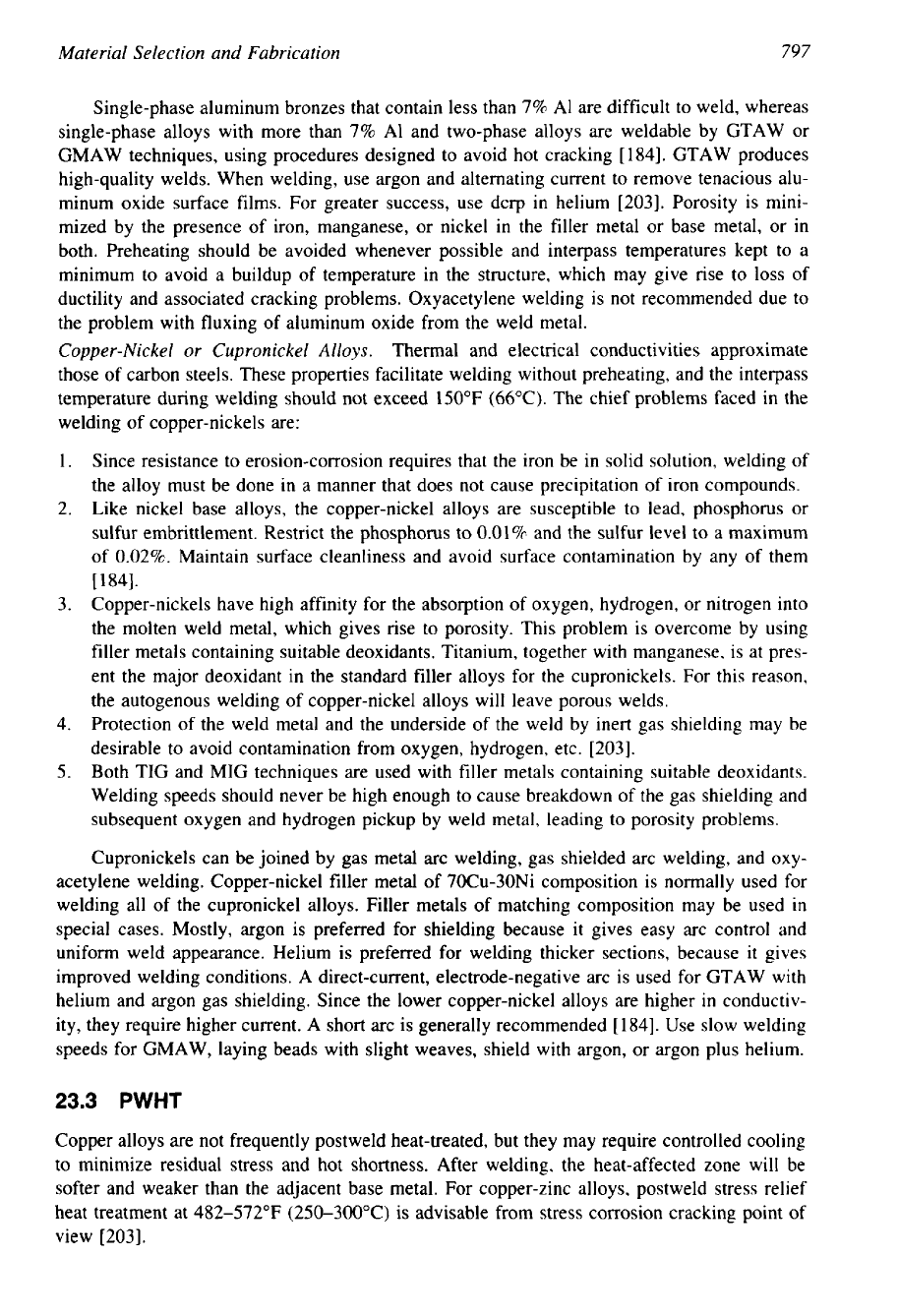
797
Material Selection and Fabrication
Single-phase aluminum bronzes that contain less than
7%
AI are difficult to weld, whereas
single-phase alloys with more than
7%
A1 and two-phase alloys are weldable by GTAW or
GMAW techniques, using procedures designed to avoid hot cracking
[
1841.
GTAW produces
high-quality welds. When welding, use argon and alternating current to remove tenacious alu-
minum oxide surface films. For greater success, use dcrp in helium
[203].
Porosity is mini-
mized by the presence of iron, manganese, or nickel in the filler metal or base metal, or in
both. Preheating should be avoided whenever possible and interpass temperatures kept to a
minimum to avoid
a
buildup of temperature in the structure, which may give rise to loss of
ductility and associated cracking problems. Oxyacetylene welding is not recommended due to
the problem with fluxing of aluminum oxide from the weld metal.
Copper-Nickel or Cupronickel Alloys.
Thermal and electrical conductivities approximate
those of carbon steels. These properties facilitate welding without preheating, and the interpass
temperature during welding should not exceed
150°F
(66°C).
The chief problems faced in the
welding of copper-nickels are:
Since resistance to erosion-corrosion requires that the iron be in solid solution, welding of
the alloy must be done in a manner that does not cause precipitation of iron compounds.
Like nickel base alloys, the copper-nickel alloys are susceptible to lead, phosphorus or
sulfur embrittlement. Restrict the phosphorus to
0.01%
and the sulfur level to a maximum
of
0.02%.
Maintain surface cleanliness and avoid surface contamination by any of them
[184].
Copper-nickels have high affinity for the absorption of oxygen, hydrogen, or nitrogen into
the molten weld metal, which gives rise to porosity. This problem is overcome by using
filler metals containing suitable deoxidants. Titanium, together with manganese, is at pres-
ent the major deoxidant in the standard filler alloys for the cupronickels. For this reason,
the autogenous welding of copper-nickel alloys will leave porous welds.
Protection of the weld metal and the underside of the weld by inert gas shielding may be
desirable to avoid contamination from oxygen, hydrogen, etc.
[203].
Both TIG and MIG techniques are used with filler metals containing suitable deoxidants.
Welding speeds should never be high enough to cause breakdown of the gas shielding and
subsequent oxygen and hydrogen pickup by weld metal, leading to porosity problems.
Cupronickels can be joined by gas metal arc welding, gas shielded arc welding, and oxy-
acetylene welding. Copper-nickel filler metal of 70Cu-30Ni composition is normally used for
welding
all
of the cupronickel alloys. Filler metals of matching composition may be used
in
special cases. Mostly, argon is preferred for shielding because
it
gives easy arc control and
uniform weld appearance. Helium is preferred for welding thicker sections, because it gives
improved welding conditions. A direct-current, electrode-negative arc is used for GTAW with
helium and argon gas shielding. Since the lower copper-nickel alloys are higher in conductiv-
ity, they require higher current.
A
short arc is generally recommended
[184].
Use slow welding
speeds for GMAW, laying beads with slight weaves, shield with argon, or argon plus helium.
23.3
PWHT
Copper alloys are not frequently postweld heat-treated, but they may require controlled cooling
to minimize residual stress and hot shortness. After welding, the heat-affected zone will be
softer and weaker than the adjacent base metal. For copper-zinc alloys, postweld stress relief
heat treatment at
482-572°F (250-300°C)
is advisable from stress corrosion cracking point of
view
[203].
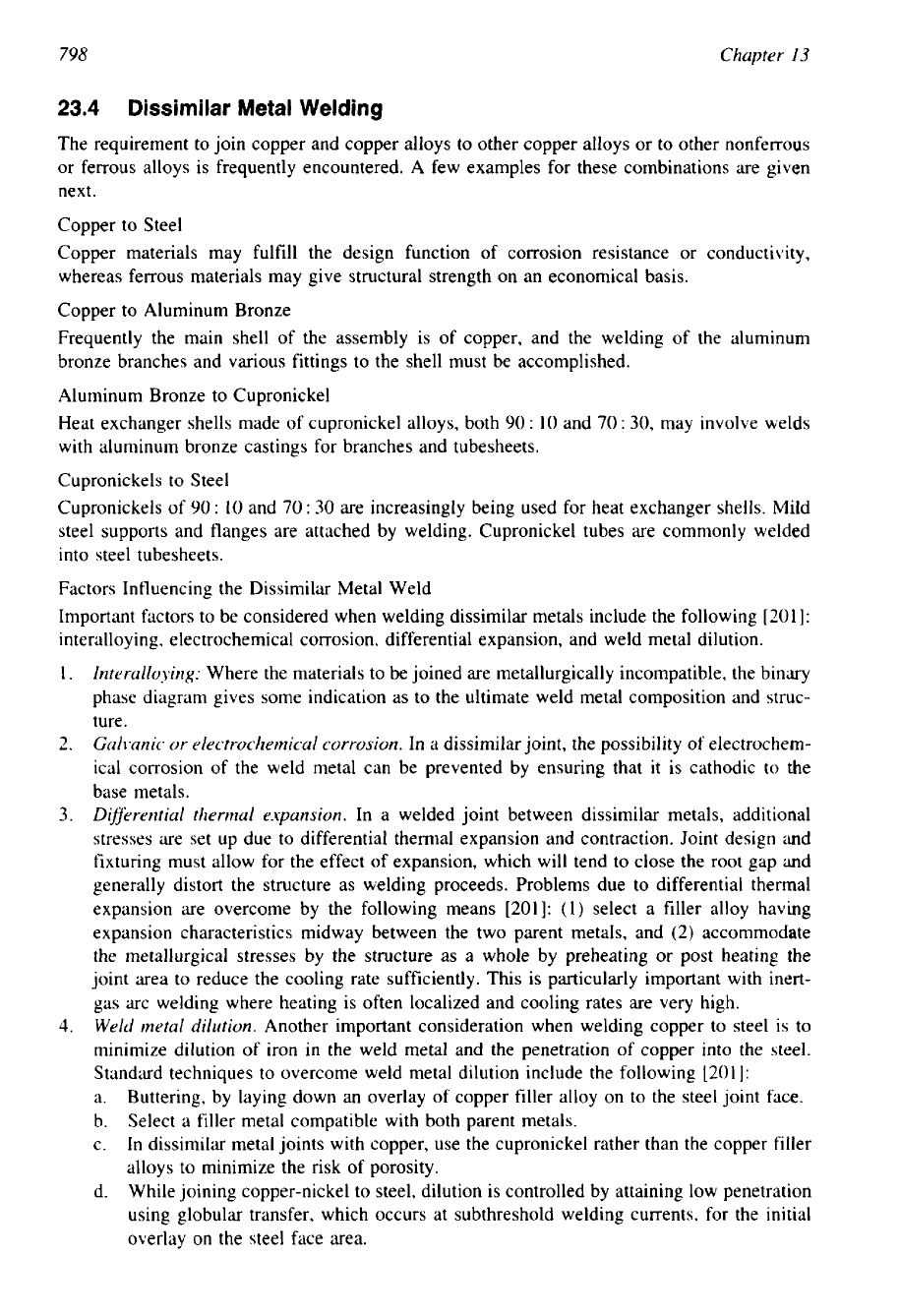
798
Chapter
I3
23.4
Dissimilar Metal Welding
The requirement to join copper and copper alloys to other copper alloys or to other nonferrous
or ferrous alloys is frequently encountered. A few examples for these combinations are given
next.
Copper to Steel
Copper materials may fulfil1 the design function
of
corrosion resistance or conductivity,
whereas ferrous materials may give structural strength on an economical basis.
Copper to Aluminum Bronze
Frequently the main shell of the assembly is of copper, and the welding of the aluminum
bronze branches and various fittings to the shell must be accomplished.
Aluminum Bronze to Cupronickel
Heat exchanger shells made of cupronickel alloys, both
90
:
10 and
70
:
30,
may involve welds
with aluminum bronze castings for branches and tubesheets.
Cupronickels to Steel
Cupronickels of
90
:
10
and
70
:
30
are increasingly being used for heat exchanger shells. Mild
steel supports and flanges are attached by welding. Cupronickel tubes are commonly welded
into steel tubesheets.
Factors Influencing the Dissimilar Metal Weld
Important factors to be considered when welding dissimilar metals include the following [201]:
interalloying, electrochemical corrosion, differential expansion, and weld metal dilution.
Znteralloying:
Where the materials to be joined are metallurgically incompatible, the binary
phase diagram gives some indication as to the ultimate weld metal composition and struc-
ture.
Gczliwnic
or
electrochernical
corrosion.
In
a
dissimilar joint, the possibility
of
electrochem-
ical corrosion of the weld metal can be prevented by ensuring that it is cathodic to the
base metals.
Di’erential thermal expansion.
In a welded joint between dissimilar metals, additional
stresses are set up due to differential thermal expansion and contraction. Joint design and
fixturing must allow for the effect of expansion, which will tend to close the root gap and
generally distort the structure as welding proceeds. Problems due to differential thermal
expansion are overcome by the following means [201]:
(1)
select a filler alloy having
expansion characteristics midway between the two parent metals, and
(2)
accommodate
the metallurgical stresses by the structure as a whole by preheating or post heating the
joint area to reduce the cooling rate sufficiently. This is particularly important with inert-
gas arc welding where heating is often localized and cooling rates are very high.
Weld
rnetul
dilution.
Another important consideration when welding copper to steel is to
minimize dilution of iron in the weld metal and the penetration of copper into the steel.
Standard techniques to overcome weld metal dilution include the following
[201]:
a.
Buttering, by laying down an overlay of copper filler alloy on to the steel joint face.
b.
Select
a
filler metal compatible with both parent metals.
c.
In dissimilar metal joints with copper, use the cupronickel rather than the copper filler
alloys to minimize the risk of porosity.
d.
While joining copper-nickel to steel, dilution is controlled
by
attaining low penetration
using globular transfer, which occurs at subthreshold welding currents, for the initial
overlay on the steel face area.
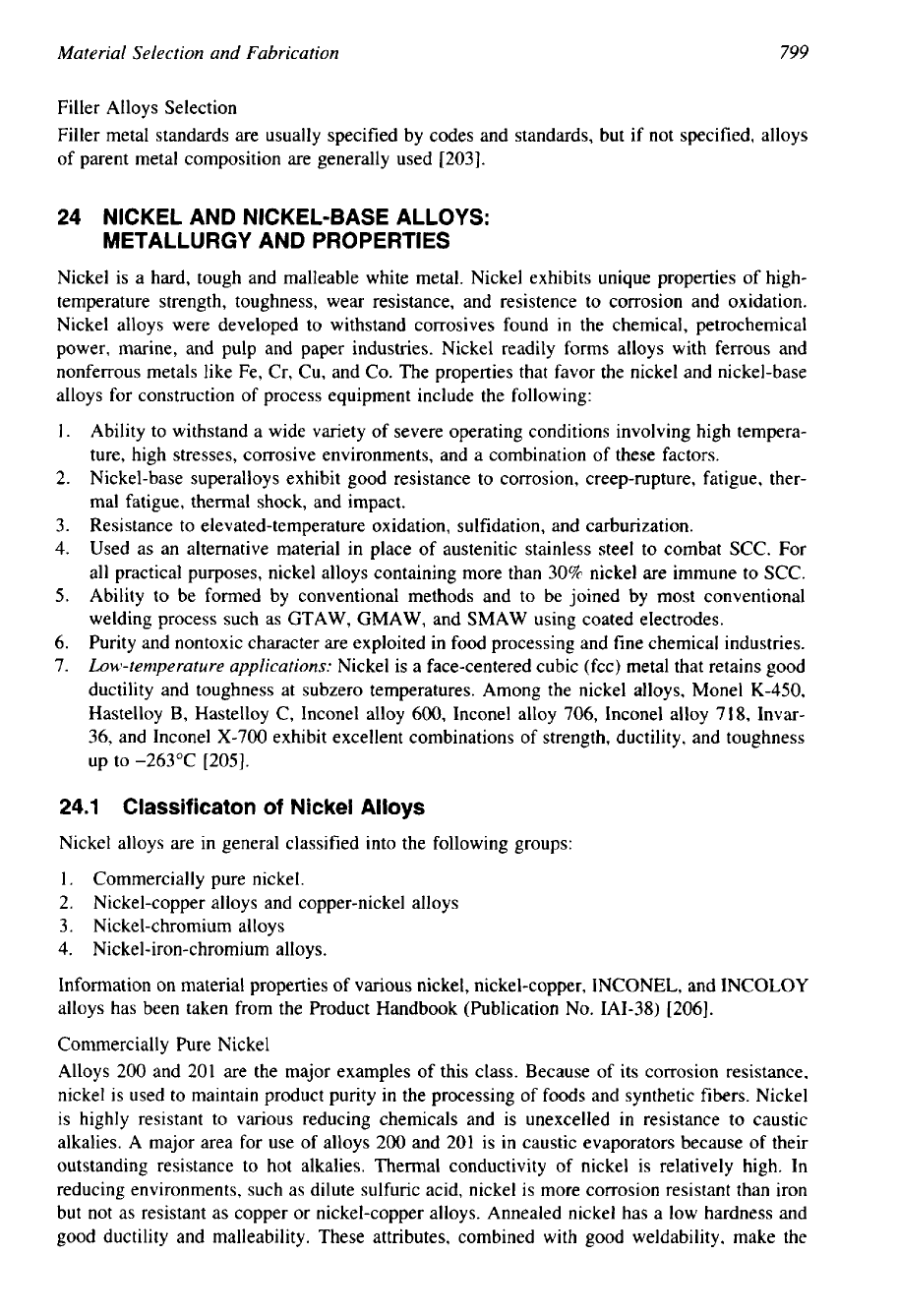
Material Selection and Fabrication
799
Filler Alloys Selection
Filler metal standards are usually specified by codes and standards, but if not specified, alloys
of parent metal composition are generally used
[203].
24
NICKEL AND NICKEL-BASE ALLOYS:
METALLURGY AND PROPERTIES
Nickel is a hard, tough and malleable white metal. Nickel exhibits unique properties of high-
temperature strength, toughness, wear resistance, and resistence to corrosion and oxidation.
Nickel alloys were developed to withstand corrosives found in the chemical, petrochemical
power, marine, and pulp and paper industries. Nickel readily forms alloys with ferrous and
nonferrous metals like Fe, Cr, Cu, and
Co.
The properties that favor the nickel and nickel-base
alloys for construction of process equipment include the following:
1.
Ability to withstand a wide variety of severe operating conditions involving high tempera-
ture, high stresses, corrosive environments, and a combination of these factors.
2.
Nickel-base superalloys exhibit good resistance to corrosion, creep-rupture, fatigue, ther-
mal fatigue, thermal shock, and impact.
3.
Resistance to elevated-temperature oxidation, sulfidation, and carburization.
4.
Used as an alternative material in place of austenitic stainless steel to combat SCC. For
all practical purposes, nickel alloys containing more than
30%
nickel are immune to SCC.
5.
Ability to be formed by conventional methods and to be joined
by
most conventional
welding process such as GTAW, GMAW, and SMAW using coated electrodes.
6.
Purity and nontoxic character are exploited in food processing and fine chemical industries.
7.
Lowtemperature applications:
Nickel is a face-centered cubic (fcc) metal that retains good
ductility and toughness at subzero temperatures. Among the nickel alloys, Monel
K-450,
Hastelloy B, Hastelloy C, Inconel alloy
600,
Inconel alloy
706,
Inconel alloy
718,
Invar-
36,
and Inconel
X-700
exhibit excellent combinations of strength, ductility, and toughness
UP
to
-263°C [205].
24.1
Classificaton of Nickel Alloys
Nickel alloys are in general classified into the following groups:
1,
Commercially pure nickel.
2.
Nickel-copper alloys and copper-nickel alloys
3.
Nickel-chromium alloys
4.
Nickel-iron-chromium alloys.
Information on material properties of various nickel, nickel-copper, INCONEL, and INCOLOY
alloys has been taken from the Product Handbook (Publication No. IAI-38)
[206].
Commercially Pure Nickel
Alloys
200
and
201
are the major examples of this class. Because of its corrosion resistance,
nickel is used to maintain product purity in the processing of foods and synthetic fibers. Nickel
is highly resistant to various reducing chemicals and is unexcelled in resistance to caustic
alkalies. A major area for use of alloys
200
and
201
is in caustic evaporators because
of
their
outstanding resistance to hot alkalies. Thermal conductivity of nickel is relatively high. In
reducing environments, such as dilute sulfuric acid, nickel is more corrosion resistant than iron
but not as resistant as copper or nickel-copper alloys. Annealed nickel has a low hardness and
good ductility and malleability. These attributes, combined with good weldability, make the
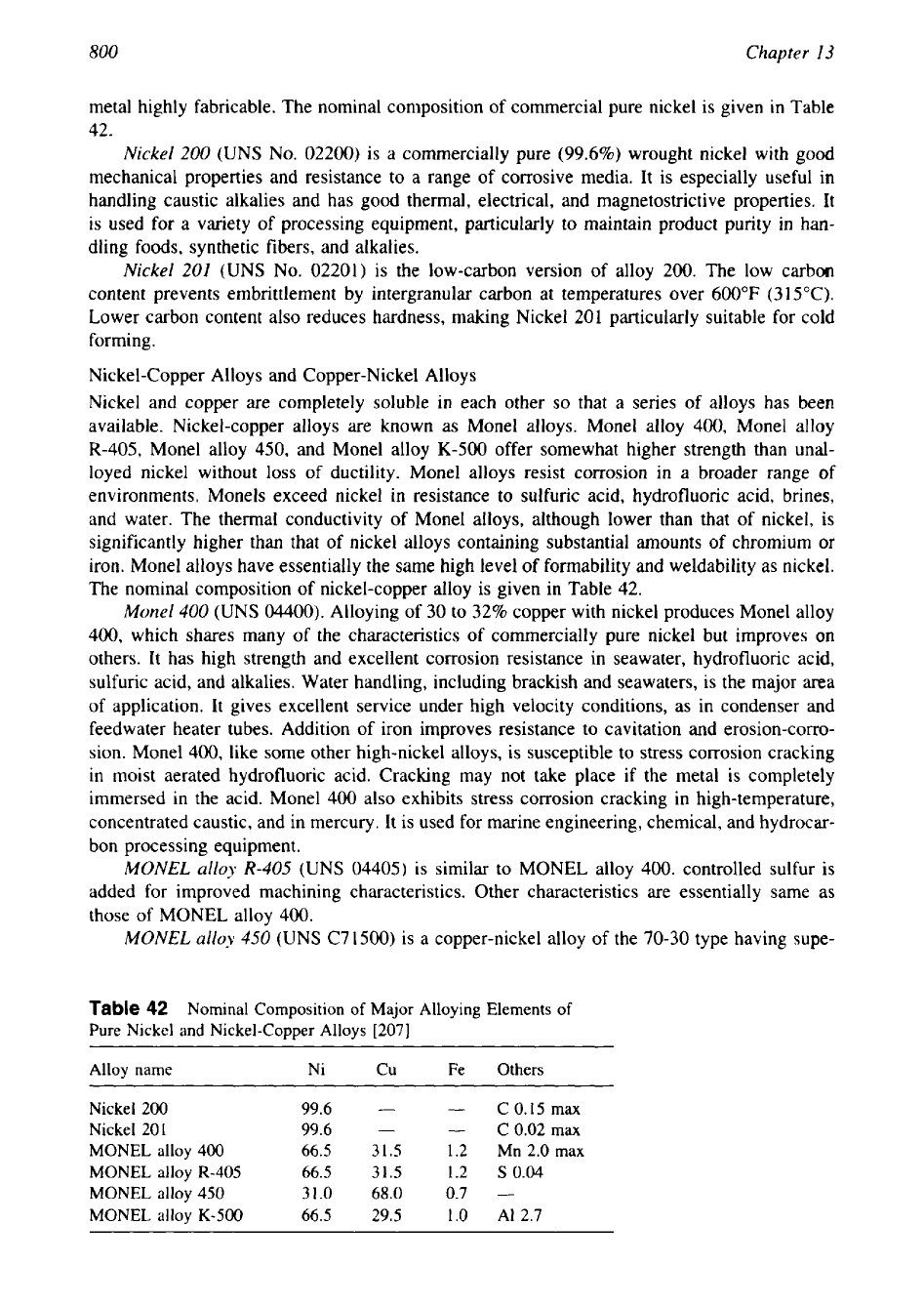
800
Chapter
13
metal highly fabricable. The nominal composition of commercial pure nickel is given in Table
42.
Nickel
200
(UNS
No.
02200) is a commercially pure
(99.6%)
wrought nickel with
good
mechanical properties and resistance to a range of corrosive media. It is especially useful in
handling caustic alkalies and has good thermal, electrical, and magnetostrictive properties.
It
is used for a variety of processing equipment, particularly to maintain product purity in han-
dling foods, synthetic fibers, and alkalies.
Nickel
201
(UNS
No.
02201)
is the low-carbon version of alloy 200. The low carbon
content prevents embrittlement by intergranular carbon at temperatures over
600°F
(3
15°C).
Lower carbon content also reduces hardness, making Nickel 201 particularly suitable for cold
forming.
Nickel-Copper Alloys and Copper-Nickel Alloys
Nickel and copper are completely soluble in each other
so
that a series of alloys has been
available. Nickel-copper alloys are known as Monel alloys. Monel alloy 400, Monel alloy
R-405, Monel alloy 450, and Monel alloy
K-500
offer somewhat higher strength than unal-
loyed nickel without loss of ductility. Monel alloys resist corrosion in a broader range of
environments. Monels exceed nickel in resistance to sulfuric acid, hydrofluoric acid, brines,
and water. The thermal conductivity of Monel alloys, although lower than that of nickel,
is
significantly higher than that of nickel alloys containing substantial amounts of chromium or
iron. Monel alloys have essentially the same high level of formability and weldability as nickel.
The nominal composition of nickel-copper alloy is given in Table 42.
Monel
400
(UNS
04400).
Alloying of
30
to 32% copper with nickel produces Monel alloy
400, which shares many of the characteristics of commercially pure nickel but improves on
others. It has high strength and excellent corrosion resistance in seawater, hydrofluoric acid,
sulfuric acid, and alkalies. Water handling, including brackish and seawaters, is the major area
of application. It gives excellent service under high velocity conditions, as in condenser and
feedwater heater tubes. Addition of iron improves resistance to cavitation and erosion-corro-
sion. Monel
400,
like some other high-nickel alloys, is susceptible to stress corrosion cracking
in moist aerated hydrofluoric acid. Cracking may not take place if the metal is completely
immersed in the acid. Monel
400
also exhibits stress corrosion cracking in high-temperature,
concentrated caustic, and in mercury. It is used for marine engineering, chemical, and hydrocar-
bon processing equipment.
MONEL
alloy
R-405
(UNS
04405)
is similar to MONEL alloy
400.
controlled sulfur is
added for improved machining characteristics. Other characteristics are essentially same as
those of MONEL alloy
400.
MONEL
alloy
450
(UNS C71500) is a copper-nickel alloy
of
the
70-30
type having supe-
Table
42
Nominal Composition
of
Major Alloying Elements
of
Pure
Nickel
and
Nickel-Copper Alloys
[207]
Alloy name Ni cu Fe Others
Nickel
200 99.6
- -
C
0.15
max
Nickel
201 99.6
- -
C
0.02
max
MONEL alloy
400 66.5 31.5 1.2
Mn
2.0
max
MONEL alloy
R-405 66.5 31.5
1.2
S
0.04
MONEL alloy
450
31.0
68.0 0.7
-
MONEL alloy
K-500 66.5 29.5
1.0
A1
2.7
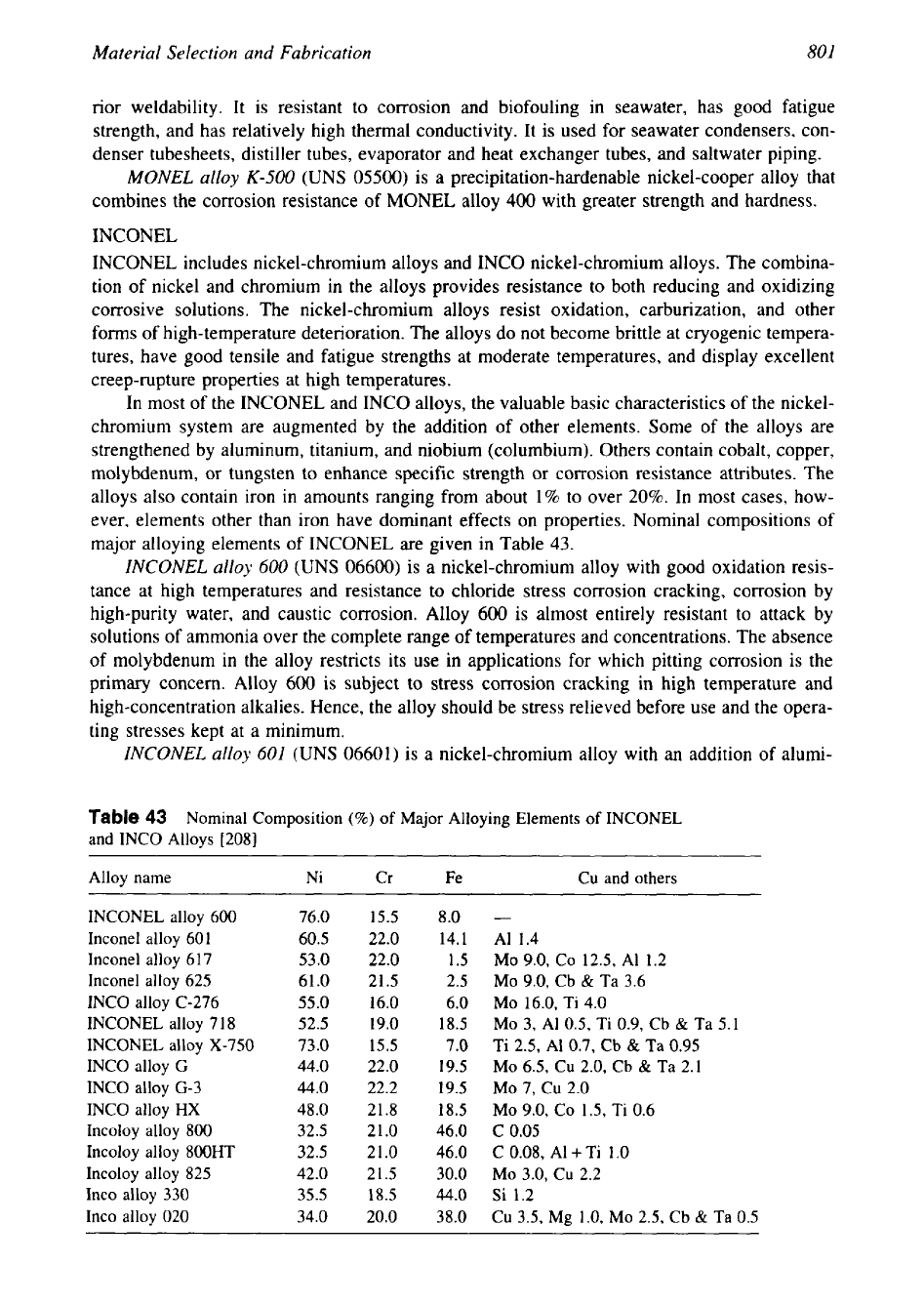
801
Material Selection and Fabrication
rior weldability. It is resistant to corrosion and biofouling in seawater, has good fatigue
strength, and has relatively high thermal conductivity. It is used for seawater condensers, con-
denser tubesheets, distiller tubes, evaporator and heat exchanger tubes, and saltwater piping.
MONEL
alloy
K-500
(UNS
05500)
is a precipitation-hardenable nickel-cooper alloy that
combines the corrosion resistance of MONEL alloy
400
with greater strength and hardness.
INCONEL
INCONEL includes nickel-chromium alloys and INCO nickel-chromium alloys. The combina-
tion of nickel and chromium in the alloys provides resistance to both reducing and oxidizing
corrosive solutions. The nickel-chromium alloys resist oxidation, carburization, and other
forms
of
high-temperature deterioration. The alloys do not become brittle at cryogenic tempera-
tures, have good tensile and fatigue strengths at moderate temperatures, and display excellent
creep-rupture properties at high temperatures.
In most of the INCONEL and INCO alloys, the valuable basic characteristics of the nickel-
chromium system are augmented by the addition of other elements. Some of the alloys are
strengthened by aluminum, titanium, and niobium (columbium). Others contain cobalt, copper,
molybdenum, or tungsten to enhance specific strength or corrosion resistance attributes. The
alloys also contain iron in amounts ranging from about
1%
to over
20%.
In most cases, how-
ever, elements other than iron have dominant effects on properties. Nominal compositions of
major alloying elements of INCONEL are given in Table
43.
ZNCONEL
alloy
600
(UNS 06600) is a nickel-chromium alloy with good oxidation resis-
tance at high temperatures and resistance to chloride stress corrosion cracking, corrosion by
high-purity water, and caustic corrosion. Alloy
600
is almost entirely resistant to attack by
solutions of ammonia over the complete range
of
temperatures and concentrations. The absence
of molybdenum in the alloy restricts its use in applications for which pitting corrosion is the
primary concern. Alloy
600
is subject to stress corrosion cracking in high temperature and
high-concentration alkalies. Hence, the alloy should be stress relieved before use and the opera-
ting stresses kept at a minimum.
INCONEL
alloy
601
(UNS 06601) is a nickel-chromium alloy with
an
addition of alumi-
Table
43
Nominal Composition
(%)
of
Major Alloying Elements
of
INCONEL
and INCO Alloys
[208]
Alloy name Ni Cr
Fe
Cu and others
INCONEL alloy
600
76.0 15.5
8.0
-
Inconel alloy
601
60.5 22.0 14.1
A1
1.4
Inconel alloy
617
53.0 22.0
1.5
MO
9.0,
CO
12.5,
A1
1.2
Inconel alloy
625
61.0 21.5
2.5
MO
9.0,
Cb
&
Ta
3.6
INCO alloy
C-276
55.0
16.0
6.0
MO
16.0,
Ti
4.0
INCONEL alloy
7
18
52.5
19.0 18.5
MO
3,
A1
0.5,
Ti
0.9,
Cb
&
Ta
5.1
INCONEL alloy
X-750
73.0
15.5 7
.O
Ti
2.5,
A1
0.7,
Cb
&
Ta
0.95
INCO alloy
G
44.0 22.0 19.5
MO
6.5,
Cu
2.0,
Cb
&
Ta
2.1
INCO alloy
G-3
44.0 22.2 19.5
MO
7,
Cu
2.0
INCO alloy
HX
48.0 21.8 18.5
MO
9.0,
CO
1.5,
Ti
0.6
Incoloy alloy
800
32.5 21.0 46.0
C
0.05
Incoloy alloy 800HT
32.5
21.0 46.0
C
0.08,
AI
+
Ti
1.0
Incoloy alloy
825
42.0
21.5
30.0
MO
3.0,
Cu
2.2
Inco alloy
330
35.5
18.5
44.0
Si
1.2
Inco alloy
020
34.0 20.0
38.0
Cu
3.5,
Mg
1.0,
MO
2.5,
Cb
&
Ta
0.5
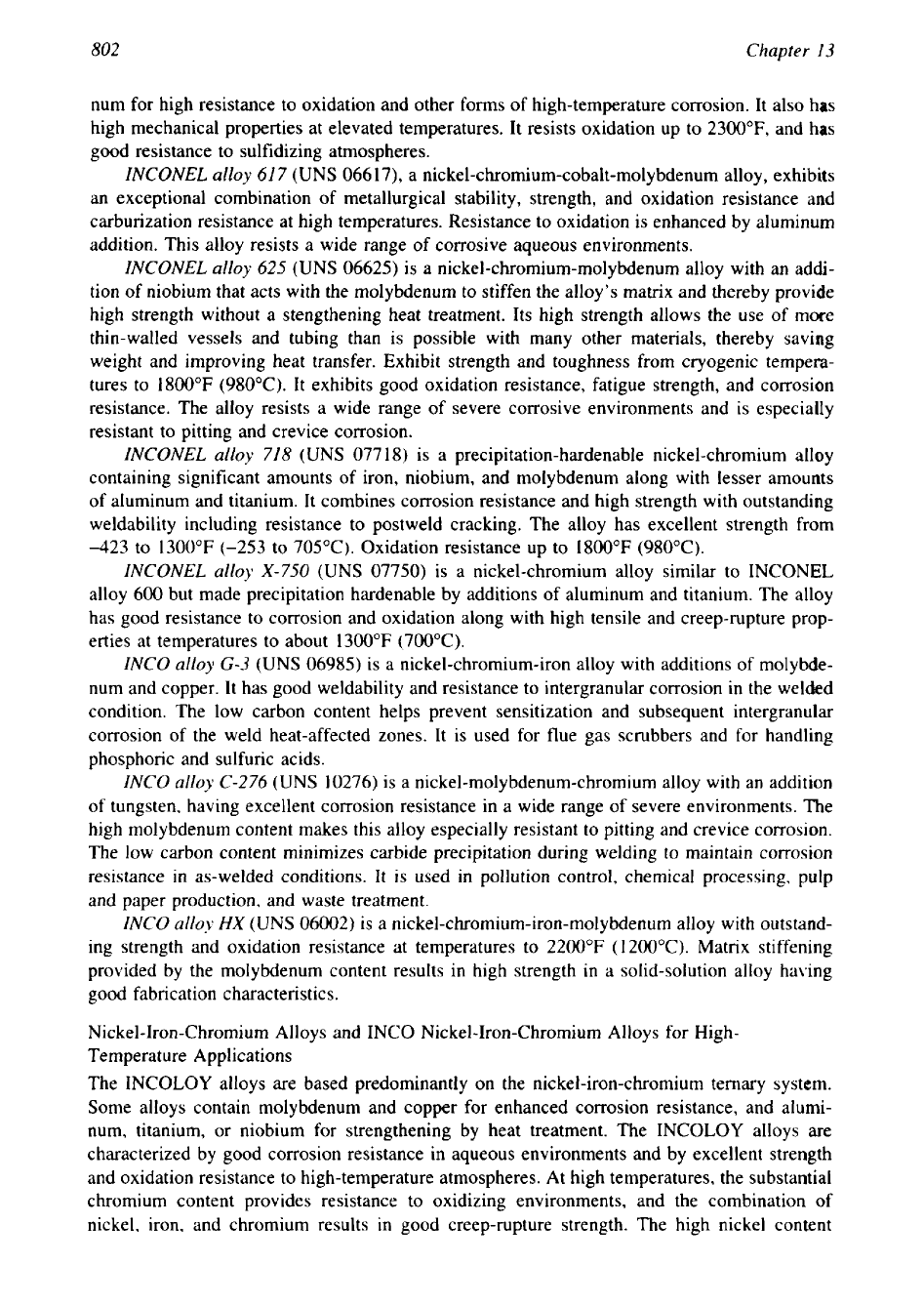
802 Chapter
13
num for high resistance to oxidation and other forms of high-temperature corrosion. It also has
high mechanical properties at elevated temperatures. It resists oxidation up to
2300"F,
and has
good resistance to sulfidizing atmospheres.
INCONEL alloy
61
7
(UNS 066 17), a nickel-chromium-cobalt-molybdenum alloy, exhibits
an exceptional combination of metallurgical stability, strength, and oxidation resistance and
carburization resistance at high temperatures. Resistance to oxidation is enhanced by aluminum
addition. This alloy resists a wide range of corrosive aqueous environments.
INCONEL alloy 625
(UNS 06625) is a nickel-chromium-molybdenum alloy with an addi-
tion of niobium that acts with the molybdenum to stiffen the alloy's matrix and thereby provide
high strength without a stengthening heat treatment. Its high strength allows the use of more
thin-walled vessels and tubing than is possible with many other materials, thereby saving
weight and improving heat transfer. Exhibit strength and toughness from cryogenic tempera-
tures to 1800°F (980°C). It exhibits good oxidation resistance, fatigue strength, and corrosion
resistance. The alloy resists a wide range
of
severe corrosive environments and is especially
resistant to pitting and crevice corrosion.
INCONEL alloy
718
(UNS 077 18) is a precipitation-hardenable nickel-chromium alloy
containing significant amounts of iron, niobium, and molybdenum along with lesser amounts
of aluminum and titanium. It combines corrosion resistance and high strength with outstanding
weldability including resistance to postweld cracking. The alloy has excellent strength from
-423 to 1300°F (-253 to 705°C). Oxidation resistance up to
1800°F
(980°C).
INCONEL alloy
X-7.50
(UNS 07750) is a nickel-chromium alloy similar to INCONEL
alloy 600 but made precipitation hardenable by additions of aluminum and titanium. The alloy
has good resistance to corrosion and oxidation along with high tensile and creep-rupture prop-
erties at temperatures to about
1300°F
(700°C).
INCO alloy
G-3
(UNS 06985) is a nickel-chromium-iron alloy with additions of molybde-
num and copper. It has good weldability and resistance to intergranular corrosion in the welded
condition. The low carbon content helps prevent sensitization and subsequent intergranular
corrosion of the weld heat-affected zones. It is used for flue gas scrubbers and for handling
phosphoric and sulfuric acids.
INCO alloy C-276
(UNS 10276) is a nickel-molybdenum-chromium alloy with an addition
of tungsten, having excellent corrosion resistance in a wide range of severe environments. The
high molybdenum content makes this alloy especially resistant to pitting and crevice corrosion.
The low carbon content minimizes carbide precipitation during welding to maintain corrosion
resistance
in
as-welded conditions. It is used in pollution control, chemical processing, pulp
and paper production, and waste treatment.
INCO alloy
HX
(UNS 06002) is
a
nickel-chromium-iron-molybdenum alloy with outstand-
ing strength and oxidation resistance
at
temperatures to 2200°F
(
1200°C). Matrix stiffening
provided by the molybdenum content results in high strength in a solid-solution alloy having
good fabrication characteristics.
Nickel-Iron-Chromium Alloys and INCO Nickel-Iron-Chromium Alloys for High-
Temperature Applications
The INCOLOY alloys are based predominantly on the nickel-iron-chromium ternary system.
Some alloys contain molybdenum and copper for enhanced corrosion resistance, and alumi-
num, titanium,
or
niobium for strengthening by heat treatment. The INCOLOY alloys
are
characterized by good corrosion resistance in aqueous environments and by excellent strength
and oxidation resistance to high-temperature atmospheres. At high temperatures, the substantial
chromium content provides resistance to oxidizing environments, and the combination of
nickel, iron, and chromium results in good creep-rupture strength. The high nickel content
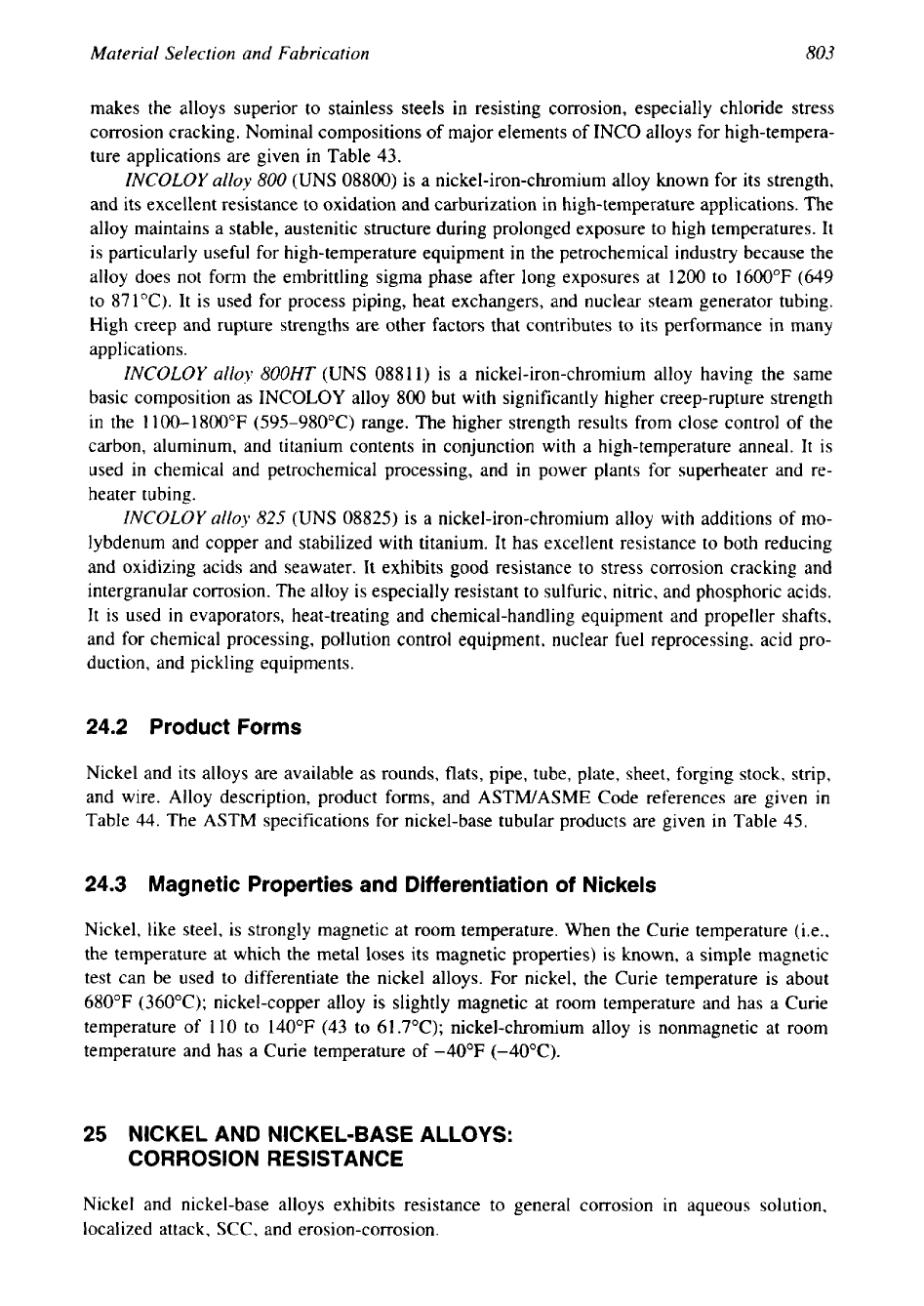
Material Selection and Fabrication
803
makes the alloys superior to stainless steels in resisting corrosion, especially chloride stress
corrosion cracking. Nominal compositions of major elements of INCO alloys for high-tempera-
ture applications are given in Table 43.
INCOLOY
alloy
800
(UNS
08800)
is a nickel-iron-chromium alloy known for its strength,
and its excellent resistance to oxidation and carburization in high-temperature applications. The
alloy maintains a stable, austenitic structure during prolonged exposure to high temperatures. It
is particularly useful for high-temperature equipment in the petrochemical industry because the
alloy does not form the embrittling sigma phase after long exposures at 1200 to 1600°F (649
to 871°C). It is used for process piping, heat exchangers, and nuclear steam generator tubing.
High creep and rupture strengths are other factors that contributes to its performance in many
applications.
INCOLOY
alloy
800HT
(UNS 0881 1) is a nickel-iron-chromium alloy having the same
basic composition as INCOLOY alloy
800
but with significantly higher creep-rupture strength
in the 1100-1800°F (595-980°C) range. The higher strength results from close control of the
carbon, aluminum, and titanium contents in conjunction with a high-temperature anneal. It is
used in chemical and petrochemical processing, and in power plants for superheater and re-
heater tubing.
INCOLOY
alloy
825
(UNS
08825)
is a nickel-iron-chromium alloy with additions of mo-
lybdenum and copper and stabilized with titanium. It has excellent resistance to both reducing
and oxidizing acids and seawater. It exhibits good resistance to stress corrosion cracking and
intergranular corrosion. The alloy is especially resistant to sulfuric, nitric, and phosphoric acids.
It is used in evaporators, heat-treating and chemical-handling equipment and propeller shafts,
and for chemical processing, pollution control equipment, nuclear fuel reprocessing, acid pro-
duction, and pickling equipments.
24.2 Product
Forms
Nickel and its alloys are available as rounds, flats, pipe, tube, plate, sheet, forging stock, strip,
and wire. Alloy description, product forms, and ASTWASME Code references are given in
Table
44.
The
ASTM
specifications for nickel-base tubular products are given in Table 45.
24.3 Magnetic Properties and Differentiation of Nickels
Nickel, like steel, is strongly magnetic at room temperature. When the Curie temperature (i.e.,
the temperature at which the metal loses its magnetic properties) is known, a simple magnetic
test can be used to differentiate the nickel alloys. For nickel, the Curie temperature is about
680°F (360°C); nickel-copper alloy is slightly magnetic at room temperature and has a Curie
temperature of 110 to 140°F (43 to 61.7"C); nickel-chromium alloy is nonmagnetic at room
temperature and has a Curie temperature of
-40°F
(-40°C).
25
NICKEL AND NICKEL-BASE ALLOYS:
CORROSION RESISTANCE
Nickel and nickel-base alloys exhibits resistance to general corrosion in aqueous solution,
localized attack,
SCC,
and erosion-corrosion.
